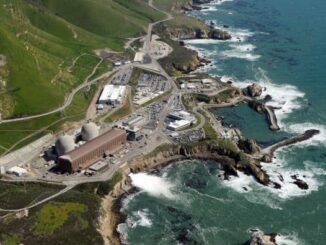
Installing residential solar could be extremely difficult for southwest Michigan residents, as the utility serving the area drastically changes the terms for new connections after reaching a cap outlined in a 2016 state law.
The law, which eliminated net metering broadly, created a program for small arrays that required utilities to compensate customers based on a set of calculations. Utilities can end that program, as Indiana Michigan Power (I&M) did for residential solar, when adoption reaches a cap of roughly .5% of the total load for that category.
Now, I&M customers who want solar will need to participate in the utility’s COGEN program, which provides much lower wholesale rates for the electricity they send back to the grid, while also promising to continue the arrangement for at least five years.
Solar developers and advocates say this will mean solar is not economically viable for many customers, just as the desire for solar was ramping up in the region.
State Sen. Jeff Irwin introduced a bill this spring that would lift the cap and restore net metering.
“That’s right, there is an arbitrary cap in Michigan law that allowed the utility to simply stop allowing residents into their DG program,” Irwin said at an Aug. 24 press conference pushing for the bill.
“If they want to plug in, they have to sign a 5-year contract, and have to accept rates that are nowhere near fair,” Irwin said. “What this means is, in practical reality, there is no access to rooftop solar. Not only are customers denied that opportunity — those installers that would have had those jobs are sidelined as well.”
Mike Westcott, development manager for the company Harvest Solar, said his team was not given any warning about the approaching cap and policy change.
“We just logged in one day [to the utility’s portal] and it said they were not accepting any more applications,” he said. “We had to let customers know, ‘Hey, you won’t be getting as much for your production as expected.’ If it stays in effect, we’ll continue to prioritize other regions that have more favorable” conditions for solar.
“Solar works really well in Michigan, especially with our high electricity rates,” said Laura Sherman, president of the Michigan Energy Innovation Business Council.
But, she said, under I&M’s new policy, customers would find it very hard to figure out when a small solar array will be paid off. The retail rate for solar hovers around 13 cents per kilowatt-hour, she explained, and residents are paid about 7 to 8 cents under the current DG program. Without the DG program, they would likely only get about 3 to 4 cents per kilowatt-hour.
“A system is never going to pencil out,” she said.
And even if the law or the utility’s DG policy on solar compensation is changed, a customer might have to wait at least a year to take advantage of it.
That’s because the five-year contract, with a requirement of one year’s notice for termination, is “a binding legal contract with a utility. I don’t want to get into a legal fight with a utility. I don’t think most customers would either.”
I&M has promised to discuss the DG cap in the rate case it will file with the Michigan Public Service Commission in the coming days. Sherman said the commission can demand a different cap or DG program. Meanwhile, she’d like to see the current program continue while the rate case is being debated.
Adam Schaller, vice president of the company Lakeshore Die Cast, has learned to negotiate the COGEN contracts that residential customers are now being asked to sign.
Lakeshore Die Cast’s 150-kilowatt and 1.25-megawatt solar arrays produce enough power for the equivalent of about 150 homes, but receiving compensation for that extra power is “complicated.”
“It doesn’t make any economic sense for projects smaller than about 500 kW, and it is hard for the utility and customers to manage,” Schaller said.
He added that “when you’re making gigawatts of power, it makes sense to sell at that wholesale rate — that’s all good. But when you’re putting up a solar array for your house, your expectation is you trade power for power. The DG tariff is close to that, but the tariff they’re proposing is way far away. You buy at retail, sell at wholesale.”
The Michigan Energy Innovation Business Council agreed. “On the whole, this tariff was not created or designed with residential customers in mind and many of the elements of this tariff are antithetical to the provision of electric service to small DG customers,” the council said in a comment filed with the Public Service Commission.
Irwin noted that Detroit-area utility DTE increased the cap this summer on its DG program from 1% to 6% of penetration, as part of a settlement with the state Public Service Commission, “after long pressure from intervening parties.”
Consumers Energy had previously lifted its cap to 4%; UPPCO, which serves the Keweenaw Peninsula, lifted its cap to 3.5%.
“What this really demonstrates is the cap is arbitrary and it’s unnecessary and it was put there not to benefit the public but to slow the development of solar on customers’ rooftops,” Irwin said.
I&M spokesperson Tracy Warner said by email that “currently, about 525 Michigan customers are on the Distributed Generation rate and will not be affected by the 1% cap. I&M wants to make clear that the company continues to assist customers and installers in pursuing the interconnection of distributed energy generation, including properties with solar panels and/or wind turbines. Customers wishing to sign up going forward can utilize the company’s co-generation program, which also credits customers who send energy onto I&M’s power grid.”
Warner said the utility has five solar farms of its own, with four more in the works, that will in all be able to power the equivalent of 225,000 homes.
State Rep. Jenn Hill noted that Michigan has a high rate of power outages, symbolized by the hundreds of thousands of households without power the day of the press conference because of a storm. Solar with batteries would give residents resiliency from outages, a role that cannot be played by solar farms that still rely on the grid to transport energy.
“With federal tax credits and future grants, all Michiganders will be able to afford to generate their own power and avoid outages,” Hill said, as long as utilities compensate people fairly for the solar energy they generate.
Sherman said the business council and other advocates would like to eliminate the cap altogether. But in the near term, she would be satisfied with extending the cap to give customers and developers seven to 10 years of regulatory certainty to take advantage of federal incentives, like the 30% investment tax credit extension under the Inflation Reduction Act.
“Some of the innovative financing options IRA opened up are allowing more work for nonprofits [and] the ability to work with innovative tax partners — there’s a lot of interest everywhere,” she said. “It’s definitely the wrong time to cut the feet out from under the solar market.”
I&M’s territory, she added, is “just a small corner of Michigan. But it’s emblematic of the problem we have the possibility of having everywhere.”



